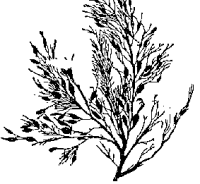 Synonyms:
Cystoseira bosphorica (Sauv.), 1912; Cystoseira crinita
(Desf.) Duby f. bosforica A.Zin.et Kalug
Synonyms:
Cystoseira bosphorica (Sauv.), 1912; Cystoseira crinita
(Desf.) Duby f. bosforica A.Zin.et KalugCystoseira crinita (Desf. Bory, 1832)
 Synonyms:
Cystoseira bosphorica (Sauv.), 1912; Cystoseira crinita
(Desf.) Duby f. bosforica A.Zin.et Kalug
Synonyms:
Cystoseira bosphorica (Sauv.), 1912; Cystoseira crinita
(Desf.) Duby f. bosforica A.Zin.et Kalug
Common names: Rom: Cistoseira, Russ: Tsistozeira bosforskaya; Turk: Bagazici yosunu.
Order (Scientific): FUCALES.
Family (Scientific): SARGASACEAE.
Taxonomic description: The thallus is over 30-40 cm; grows in the same conditions as Cystoseira barbata. The stem is short or is stretched along the whole stem almost 2 mm high, the main branches are 5-10 cm long, 1 mm thick, branches branch out alternatively. The surface of the stem and branches is smooth. The branches are cylindrical shaped with a large number of crystostoma coming out on the surface in tuber shapes visible to the naked eye. The number of (air) bladders is small, interspersed or superficial, 1 or 2 on small branches with considerable and at a certain distance from one another; the (air) bladders are large enogh, 4-8 mm long and 3-4 mm thick, are ellipsoidal, sometimes with a lateral growth, or split such a pitchfork; the top of the last bladders are blunded. Cylindrical or spareshaded receptacles are placed on the top of the branches, often with bladders and sometimes with some small thorns on the surface, without sterile shoots on the top.
 IUCN Status:
IUCN Status:
World level:
Black Sea Regional level:
Subregion level: EN, on the north-western
and western shelves
Distribution:
Habitats type, Critical habitats, Limiting factors: Rocky bottoms on pebbly grounds in sublittoral areas. Suspended particles hindering light penetration.
Biology: Perennial, fond of light; reproduction occurs at a depth 0,5-5m . Endemic.
Population trends: Almost disappeared.
Threats: Hard frosts, hydrotechnical constructions, silting of the rocky bottom by suspended matter, lowering of light energy penetration through the water column, eutrophication.
Conservation measures taken: None.
Conservation measures proposed: Reduce eutrophication and pollution from point and non-point sources; organization of natural submarine park.
References:
Compiled by: A.Bologa, A.Bavaru, K.Dencheva.